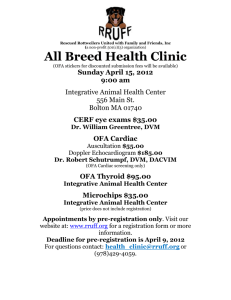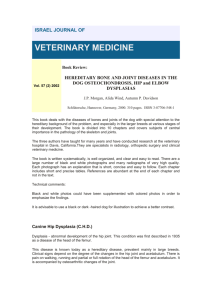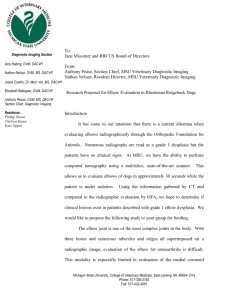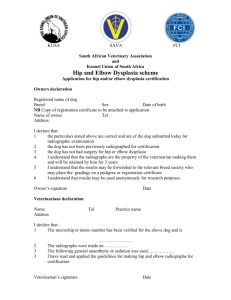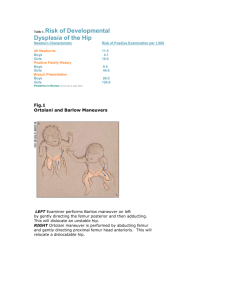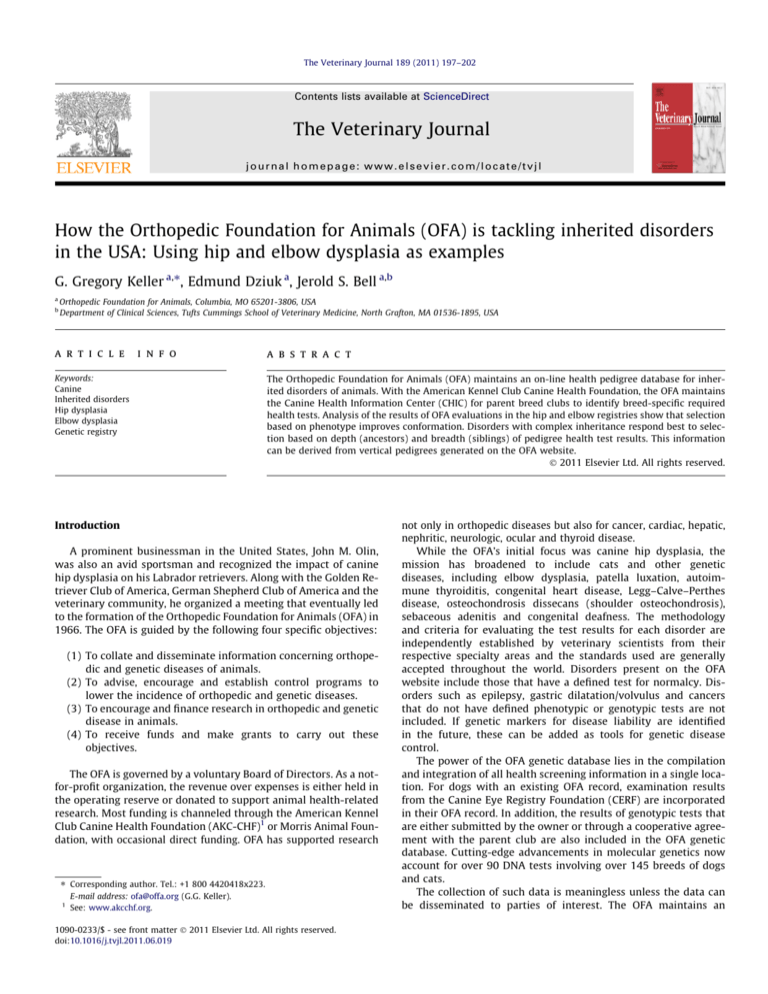
The Veterinary Journal 189 (2011) 197–202
Contents lists available at ScienceDirect
The Veterinary Journal
journal homepage: www.elsevier.com/locate/tvjl
How the Orthopedic Foundation for Animals (OFA) is tackling inherited disorders
in the USA: Using hip and elbow dysplasia as examples
G. Gregory Keller a,⇑, Edmund Dziuk a, Jerold S. Bell a,b
a
b
Orthopedic Foundation for Animals, Columbia, MO 65201-3806, USA
Department of Clinical Sciences, Tufts Cummings School of Veterinary Medicine, North Grafton, MA 01536-1895, USA
a r t i c l e
i n f o
Keywords:
Canine
Inherited disorders
Hip dysplasia
Elbow dysplasia
Genetic registry
a b s t r a c t
The Orthopedic Foundation for Animals (OFA) maintains an on-line health pedigree database for inherited disorders of animals. With the American Kennel Club Canine Health Foundation, the OFA maintains
the Canine Health Information Center (CHIC) for parent breed clubs to identify breed-specific required
health tests. Analysis of the results of OFA evaluations in the hip and elbow registries show that selection
based on phenotype improves conformation. Disorders with complex inheritance respond best to selection based on depth (ancestors) and breadth (siblings) of pedigree health test results. This information
can be derived from vertical pedigrees generated on the OFA website.
Ó 2011 Elsevier Ltd. All rights reserved.
Introduction
A prominent businessman in the United States, John M. Olin,
was also an avid sportsman and recognized the impact of canine
hip dysplasia on his Labrador retrievers. Along with the Golden Retriever Club of America, German Shepherd Club of America and the
veterinary community, he organized a meeting that eventually led
to the formation of the Orthopedic Foundation for Animals (OFA) in
1966. The OFA is guided by the following four specific objectives:
(1) To collate and disseminate information concerning orthopedic and genetic diseases of animals.
(2) To advise, encourage and establish control programs to
lower the incidence of orthopedic and genetic diseases.
(3) To encourage and finance research in orthopedic and genetic
disease in animals.
(4) To receive funds and make grants to carry out these
objectives.
The OFA is governed by a voluntary Board of Directors. As a notfor-profit organization, the revenue over expenses is either held in
the operating reserve or donated to support animal health-related
research. Most funding is channeled through the American Kennel
Club Canine Health Foundation (AKC-CHF)1 or Morris Animal Foundation, with occasional direct funding. OFA has supported research
⇑ Corresponding author. Tel.: +1 800 4420418x223.
1
E-mail address: ofa@offa.org (G.G. Keller).
See: www.akcchf.org.
1090-0233/$ - see front matter Ó 2011 Elsevier Ltd. All rights reserved.
doi:10.1016/j.tvjl.2011.06.019
not only in orthopedic diseases but also for cancer, cardiac, hepatic,
nephritic, neurologic, ocular and thyroid disease.
While the OFA’s initial focus was canine hip dysplasia, the
mission has broadened to include cats and other genetic
diseases, including elbow dysplasia, patella luxation, autoimmune thyroiditis, congenital heart disease, Legg–Calve–Perthes
disease, osteochondrosis dissecans (shoulder osteochondrosis),
sebaceous adenitis and congenital deafness. The methodology
and criteria for evaluating the test results for each disorder are
independently established by veterinary scientists from their
respective specialty areas and the standards used are generally
accepted throughout the world. Disorders present on the OFA
website include those that have a defined test for normalcy. Disorders such as epilepsy, gastric dilatation/volvulus and cancers
that do not have defined phenotypic or genotypic tests are not
included. If genetic markers for disease liability are identified
in the future, these can be added as tools for genetic disease
control.
The power of the OFA genetic database lies in the compilation
and integration of all health screening information in a single location. For dogs with an existing OFA record, examination results
from the Canine Eye Registry Foundation (CERF) are incorporated
in their OFA record. In addition, the results of genotypic tests that
are either submitted by the owner or through a cooperative agreement with the parent club are also included in the OFA genetic
database. Cutting-edge advancements in molecular genetics now
account for over 90 DNA tests involving over 145 breeds of dogs
and cats.
The collection of such data is meaningless unless the data can
be disseminated to parties of interest. The OFA maintains an
198
G.G. Keller et al. / The Veterinary Journal 189 (2011) 197–202
on-line database of >1 million phenotypic and genotypic test results.2 All normal or grades of normal results in the OFA database
are available on-line. Abnormal or grades of abnormal results are
available on-line if released by the owner, or if the results are part
of a breed club program where all (normal and abnormal) test results are published.
The Canine Health Information Center (CHIC)3 is a program that
is dually sponsored by the OFA and the AKC-CHF. The parent clubs
determine the breed-specific health issues for CHIC certification
and encourage breeder participation in the program. The CHIC program is not about normalcy; it is about health consciousness. Dogs
receive CHIC certification if they have completed the required
breed-specific health testing, regardless of the test results. Other
requirements include permanent identification (tattoo or microchip)
and release to the open database of abnormal results. CHIC encourages health screening to improve the overall health of breeds. There
are presently over 139 parent breed clubs participating, with over
64,500 dogs achieving CHIC certification.
The acceptance of the CHIC certification program by parent
breed clubs and breeders provides an avenue for the only proven
method of genetic disease control: breed-specific phenotypic and
genotypic screening of prospective breeding stock. The CHIC program provides a standard for breeders to practice health-conscious
breeding. It also allows pet owners to screen prospective purchases
for evidence of health-conscious breeding.
Another goal of the CHIC program is to collect and store canine
DNA samples, along with corresponding genealogic and phenotypic information, to facilitate future research and testing aimed
at reducing the incidence of inherited disease in dogs. Researchers
have been hampered by the lack of appropriate DNA samples and
the DNA repository addresses this need. To date, the CHIC DNA
Repository contains DNA from over 12,500 dogs and has received
17 requests from researchers, resulting in the distribution of over
2,200 DNA samples with their appropriate health and pedigree
information.
To evaluate hip dysplasia, the OFA employs the ventrodorsal
hip-extended positioning recommended by the American Veterinary Medical Association (AVMA Council on Veterinary Service,
1961). The in-house radiologist is the sole evaluator for preliminary evaluation of dogs <24 months of age. The reliability of preliminary hip evaluations for predicting of-age OFA ratings was
demonstrated by Corley et al. (1997). Dogs or cats must be
P24 months of age to receive OFA hip certification. Radiographs
are independently evaluated by three board-certified veterinary
radiologists out of a pool of consultants maintained by the OFA.
The consensus rating of these three radiologists becomes the hip
rating that is reported to the owner and referring veterinarian.
There is a high degree of inter- and intra-reader correlation for
conventional and digital images (Corley, 1992; Essman and Sherman, 2006).
Seven OFA hip ratings are reported: Excellent, Good, Fair, Borderline, Mild, Moderate or Severe. The first three ratings are considered to be normal, while the last three ratings are regarded as
dysplastic. A Borderline rating is given when there is no clear consensus between radiologists to place the hips in a category of normal or dysplastic. It is recommended that dogs with this rating
have a repeat radiograph submitted after a minimum of 6 months.
The OFA elbow dysplasia registry employs the protocol established by the International Elbow Working Group (IEWG),4 which
consists of Normal or Grades I, II or III Dysplastic based on the severity of secondary osteoarthritis/degenerative joint disease present on
an extreme flexed mediolateral view (International Elbow Working
Group, 2001). When a specific component of elbow dysplasia is observed, it is reported in addition to the Grade as ununited anconeal
process, osteochondrosis or fragmented medical coronoid process.
Elbow radiographs are subjected to the same of-age or preliminary
evaluation and certification process as hip radiographs.
Diseases with complex inheritance can respond to selective
pressure based on phenotype (Keller, 2006; Pirchner, 1983). In this
manuscript, the OFA hip and elbow registries are used to illustrate
this response.
Materials and methods
The OFA hip registry of 1,187,831 evaluations was queried for hip ratings of
progeny where both parents also had known of-age hip ratings. Data were collected
on progeny with of-age or preliminary hip confirmation ratings of normal (Excellent, 1; Good, 2; Fair, 3) or dysplastic (Mild, 5; Moderate, 6; Severe, 7). Progeny with
Borderline (4) hip ratings were not included. The hip ratings of both parents were
recorded, including all seven grades. A hip Combined Parent Score (CPS) for each
mating was determined by adding together the numbers corresponding to the
hip rating for each parent; for two OFA Excellent parents the CPS was 2 and for
two OFA Severe parents the CPS was 14. Matings with the same CPS were combined
together for analysis; e.g. Good mated to Borderline, Fair mated to Fair and Excellent mated to Mild all have a CPS of 6.
The OFA elbow registry of 260,195 evaluations was queried for elbow ratings of
progeny where both parents had known of-age elbow ratings. Data were collected
on progeny with preliminary or of-age elbow confirmation ratings of Normal (1) or
dysplastic (Grade I, 2; Grade II, 3; Grade III, 4). An elbow CPS for each mating was
determined by adding together the numbers corresponding to the elbow rating for
each parent; for two OFA Normal parents the CPS was 2 and for two OFA Grade III
parents the CPS was 8. Matings with the same CPS were combined together for
analysis.
Pearson correlation analysis was performed to compare the CPS of matings to
the observed percentages of hip dysplasia or elbow dysplasia in the progeny.
Results
Table 1 shows the hip ratings for 490,966 progeny in the OFA
hip registry with known sire and dam hip ratings. The percentage
of dysplastic progeny increased as the parental hip scores increased. The total number of hip radiograph submissions from parents with normal hip ratings was significantly greater than those
from parents with dysplastic hip ratings (P > 0.05).
Fig. 1 shows the relationship between the CPS and the percentage of dysplastic progeny. Matings with the same CPS (on the diagonal of Table 1) were strongly correlated with increasing
percentages of dysplastic progeny (Pearson correlation coefficient
r = 0.96; P > 0.05). The single CPS that did not reflect this trend
was for matings between two severely dysplastic parents, where
only 18 progeny were submitted for evaluation.
Table 2 shows the elbow ratings for 67,599 progeny in the OFA
elbow registry with known sire and dam elbow ratings. Matings
including one normal parent had significantly lower percentages
of progeny with elbow dysplasia (12.4%) than those between two
parents with elbow dysplasia (45.4%) (P > 0.05). Matings involving
a parent with Grade I elbow dysplasia produced significantly more
elbow dysplasia (25.6%) than matings including a parent with normal elbows (v2 = 0.77, 6 df, P = 0.99).
Fig. 2 shows the relationship between the CPS and the percentage of progeny with elbow dysplasia. The Pearson correlation coefficient between the CPS and percentage of dysplastic progeny was
r = 0.06. The lack of correlation is due to the low percentage of dysplasia in progeny of Grade III sires bred to Grade II dams, and Grade
III parents bred to each other. The total number of progeny from
these matings numbered 14 and 3, respectively.
Discussion
2
3
4
See: www.offa.org.
See: www.caninehealthinfo.org.
See: www.iewg-vet.org/.
The OFA hip data and CPS demonstrate that hip dysplasia is
inherited in an additive and quantitative manner. This verifies
199
G.G. Keller et al. / The Veterinary Journal 189 (2011) 197–202
Table 1
Progeny results of matings between parents with known hip scores.
Sire rating
Excellent (1)
Dysplastic (%)
Total
Good (2)
Dysplastic (%)
Total
Fair (3)
Dysplastic (%)
Total
Borderline (4)
Dysplastic (%)
Total
Mild (5)
Dysplastic (%)
Total
Moderate (6)
Dysplastic (%)
Total
Severe (7)
Dysplastic (%)
Total
Total
Dam rating
Total
Excellent (1)
Good (2)
Fair (3)
Borderline (4)
Mild (5)
Moderate (6)
Severe (7)
3.6
17,972
6.1
52,784
9.6
9039
12.3
155
13.4
1271
18.7
729
18.5
65
82,015
5.8
50,485
9.6
217,938
14.6
49,212
17.5
811
18.9
6930
23.0
3973
31.5
461
329,810
9.4
6241
14.1
41,628
19.8
13,513
22.8
263
26.5
2301
32.2
1328
37.1
167
65,441
8.9
79
17.7
532
20.2
168
22.2
9
30.8
39
50.0
30
50.0
4
861
16.4
807
18.3
4531
27.2
1532
36.2
47
29.6
459
41.4
239
45.0
40
7655
18.9
428
22.8
2618
31.6
896
34.4
32
35.0
266
38.0
213
65.3
49
4502
22.0
59
24.2
360
36.0
136
44.4
9
39.6
48
55.8
52
44.4
18
682
76,071
320,391
74,496
1326
11,314
6564
804
490,966
Fig. 1. Relationship of Combined Parent Score to percentage of hip dysplastic progeny.
the conclusions of other researchers that canine hip dysplasia is
inherited as a quantitative trait (Leighton, 1997; Zhu et al., 2009;
Hou et al., 2010). Hou et al. (2010) analyzed all Labrador retrievers
in the open-access OFA hip database and calculated an heritability
of 0.21, which confirms hip dysplasia acting as a moderately heritable disease. They also confirmed a steady genetic improvement
of OFA hip ratings in the breed over a 40 year period. These results
validate the OFA recommendation that using parents with better
phenotypic hip conformation produces offspring with better hips.
It was expected that fewer radiographs would be submitted for
the progeny of two dysplastic parents, since fewer breeders perform such matings. The low numbers may also be due to pre-
200
G.G. Keller et al. / The Veterinary Journal 189 (2011) 197–202
Table 2
Progeny results of matings between parents with known elbow scores.
Sire rating
Normal (1)
Dysplastic
(%)
Total
Grade I (2)
Dysplastic
(%)
Total
Grade II (3)
Dysplastic
(%)
Total
Grade III (4)
Dysplastic
(%)
Total
Total
Dam rating
Total
Normal
(1)
Grade I
(2)
Grade II
(3)
Grade III
(4)
10.1
24.1
29.4
28.1
55,867
4309
875
167
22.0
41.0
46.9
52.2
3917
591
145
23
32.6
55.4
65.8
57.1
1121
222
38
14
23.9
38.1
14.3
0.0
251
42
14
3
61,156
5164
1072
207
61,218
4676
1395
310
67,599
screening of radiographs with obviously dysplastic hips by veterinarians; these radiographs may not be submitted to the OFA for
evaluation (Paster et al., 2005). This would reduce the resultant frequencies of dysplastic individuals. Prescreening of dysplastic
radiographs for OFA submission appears to be constant over time
(Reed et al., 2000).
Traits such as hip dysplasia and elbow dysplasia are complexly
(polygenically) inherited, with increasing incidence based on
increasing frequencies of susceptibility alleles at loci that contribute to variation in liability. Selection based on vertical or depth-ofpedigree hip ratings (parents and grandparents), when combined
with an individual’s own rating, increases the accuracy of selection
and hence response to selection. Similarly, selection based on horizontal or breadth-of-pedigree hip ratings (siblings), when combined with an individual’s own rating, increases accuracy of
selection and hence response to selection (Pirchner, 1983; Keller,
2006).
Breeding schemes that employ estimated breeding values
(EBVs) that combine phenotypic ratings from all known relatives
(weighted according to genetic relationship) provide the greatest
selective power, rather than single measurements on individual
dogs (Zhu et al., 2009; Hou et al., 2010). EBVs that utilize molecular
genetic markers for liability genes would be even more beneficial
(Stock and Distl, 2010; Zhou et al., 2010).
The open-access OFA health database website provides breeders with the information that helps them to make informed breeding decisions. When an individual dog’s record is accessed, detailed
information on all recorded health issues, including test results,
age at the time of testing and the resulting certification numbers,
are available. Sire and dam information are provided, as well as
information on full and half siblings and any offspring that may
be in the database. A vertical pedigree can be generated from a link
on the individual’s OFA page, providing traditional depth of pedigree and breadth of pedigree health information. This type of data
is extremely useful when trying to make selection decisions based
on phenotypic data.
The vertical hip pedigree of the Golden retriever Champion (Ch.)
Faera’s Starlight (Fig. 3) shows how parent, grandparent, offspring
and sibling information are combined in a single graphic format for
evaluation. Whilst this dog had hips with an Excellent rating, he
was bred from Fair- and Good-rated parents, with three Fair- and
one Good-rated grandparents. While he produced 92.4% normal
offspring with a preponderance of Good ratings, he produced more
Fair- than Excellent-rated offspring. The vertical pedigree provides
more information than the single individual rating. Vertical
Fig. 2. Relationship of Combined Parent Score to percentage of elbow dysplastic progeny.
G.G. Keller et al. / The Veterinary Journal 189 (2011) 197–202
201
Fig. 3. OFA vertical pedigree of Golden retriever Ch. Faera’s Starlight.
pedigrees of individual animals are available on the OFA website
for the hip, elbow, cardiac, thyroid, patella, CERF (eye) and degenerative myelopathy registries.
EBV technology would combine all of the phenotypic information in Fig. 3 into a single measurement that provides the most
accurate possible prediction of the average performance of the offspring of the dog in question (Faera’s Starlight). However, the individual’s OFA page and vertical pedigree allows the breeder to
determine where the liability comes from in the pedigree, the specific results from each mating and each dog’s strengths and weaknesses. These are useful tools for selection and genetic
improvement.
The distraction index (DI) measurement of the PennHIP method
for hip dysplasia control employs a mechanical distraction device
to measure maximal hip joint laxity as a predictor of future degenerative joint disease and osteoarthritis (Smith et al., 1990). PennHIP studies show that the OFA rating and DI measurement are
significantly associated (Powers et al., 2010) and DI measurements
submitted by their owners to the OFA are included in the hip dysplasia registry.
While the DI provides a measurement of laxity, it does not take
into account degenerative joint disease or osteoarthritic changes.
Studies have shown that liability for hip dysplasia and liability
for osteoarthritis are controlled by separate genes (Clements
et al., 2006; Zhou et al., 2010). The OFA hip rating incorporates
an evaluation of both subluxation on the ventrodorsal hip-extended view, as well as radiographic anatomy and secondary
boney changes.
The PennHIP method recommends selection based on the DI
measurement of individual dogs. Based on PennHIP data of dogs
presented to the University of Pennsylvania School of Veterinary
Medicine, 100% of Golden retrievers and 89% of Labrador retrievers
who received normal OFA ratings were deemed osteoarthritis-susceptible by their DI (Powers et al., 2010). Powers et al. (2010) also
raised the possibility that the Cardigan Welsh Corgi is genetically
fixed for hip dysplasia, based on DI measurements for the breed.
However, the clinical presentation of disease in these breeds does
not bear out these predictions, suggesting that there is a high falsepositive rate for DI prediction of clinical disease. A study correlating ventrodorsal hip-extended radiographic ratings to later insurance-related claims for hip dysplasia showed a strong association
(Malm et al., 2010). Data correlating DI measurements to morbidity from clinical disease have not been published.
Dog breeds have closed stud books and dog breeders have concerns about genetic diversity and the effects of artificial selection
on their gene pools (Calboli et al., 2008). The removal of 89% or
more of possible breeding stock for a single genetic disorder
(which would be required in order to breed only from those Labrador retrievers with acceptable DI) will doom any breed to extinction from genetic depletion. While breeding from only OFA
202
G.G. Keller et al. / The Veterinary Journal 189 (2011) 197–202
Excellent dogs will significantly improve hip ratings of progeny,
the elimination of the rest of the phenotypically normal dogs from
breeding (most of which produce predominantly normal dogs)
would also severely restrict the gene pools of breeds. Pragmatic
breeding recommendations include breeding from normal dogs
with increasing normalcy of parents, grandparents, siblings and
progeny, as shown on the OFA vertical pedigree, and through the
use of EBVs.
The significant difference between progeny from one parent
with normal elbows and progeny from two parents with dysplastic
elbows suggests a qualitative trait. However, it is established that
elbow dysplasia is a polygenic (multifactorial) trait (Engler et al.,
2009). Increasing CPS tended to increase the frequency of elbow
dysplasia in the progeny, but low numbers of submissions for some
mating types between dysplastic parents skewed the results, making the correlation inconclusive. Again, pre-screening and non-submission to OFA of obviously dysplastic radiographs may have
affected the data.
Grade I elbow dysplasia is a radiographic diagnosis that usually
does not produce clinical disease or morbidity in the dog. Some
breed groups counsel owners to ignore the diagnosis of Grade I elbow dysplasia and to treat these dogs as if they were normal. However, the data presented here demonstrates that progeny from a
parent with Grade I elbow dysplasia, when bred to mates from
all other rating classifications, have a significantly increased frequency of elbow dysplasia. These results are significantly different
from the results observed with progeny from one normal parent
bred to mates from all other rating classifications.
The data show that even two dogs with normal elbow radiographs may produce 10.1% progeny with elbow dysplasia. This is
where consideration of depth and breadth of pedigree information
becomes important. Any rating of elbow dysplasia in siblings of
dogs with a normal elbow rating provides evidence that the normal
dog may carry additional elbow dysplasia liability alleles.
Selection for increasing normalcy of depth and breadth of pedigree information provides a better selection tool for complexly
inherited disease. The use of the OFA vertical pedigree provides
the information necessary to make informed breeding decisions.
The addition of EBVs that combine all of this information (Engler
et al., 2009) and that also include genotypes of DNA markers for
liability genes (Stock and Distl, 2010; Zhou et al., 2010) would be
even more beneficial.
Conclusions
The OFA data show that hip and elbow conformation improve
with improving parental phenotypic ratings. The open access OFA
website provides health test results on individuals, as well as depth
and breadth of pedigree health information on closely related individuals. This information provides the best means for making
breeding decisions for both complexly inherited and Mendelian
disorders.
Conflict of interest statement
The authors are Chief of Veterinary Services (GGK), Chief Operating Officer (ED) and Director (JSB) of the not-for-profit Orthopedic Foundation for Animals.
Acknowledgement
The authors thank Ms. Rhonda Hovan for allowing use of the
pedigree of Ch. Faera’s Starlight.
References
AVMA Council on Veterinary Service, 1961. Report of panel on canine hip dysplasia.
Journal of the American Veterinary Medical Association 139, 791–798.
Calboli, F.C., Sampson, J., Fretwell, N., Balding, D.J., 2008. Population structure and
inbreeding from pedigree analysis of purebred dogs. Genetics 179, 593–601.
Clements, D.N., Carter, S.D., Innes, J.F., Ollier, W.E., 2006. Genetic basis of secondary
osteoarthritis in dogs with joint dysplasia. American Journal of Veterinary
Research 67, 909–918.
Corley, E., 1992. Role of the Orthopedic Foundation for Animals in the control of
canine hip dysplasia. Veterinary Clinics of North America Small Animal Practice
22, 579–593.
Corley, E.A., Keller, G.G., Lattimer, J.C., Ellersieck, M.R., 1997. Reliability of early
radiographic evaluations for canine hip dysplasia obtained from the standard
ventrodorsal radiographic projection. Journal of the American Veterinary
Medical Association 211, 1142–1146.
Engler, J., Hamann, H., Distl, O., 2009. Schätzung populationsgenetischer parameter
für röntgenologische befunde der ellbogengelenkdysplasie beim Labrador
retriever. Berliner und Münchener Tierärztliche Wochenschrift 122, 378–385.
Essman, S., Sherman, A., 2006. Comparison of digitized and conventional
radiographic images for assessment of hip joint conformation of dogs.
American Journal of Veterinary Research 67, 1546–1551.
Hou, Y., Wang, Y., Lust, G., Zhu, L., Zhang, Z., Todhunter, R.J., 2010. Retrospective
analysis for genetic improvement of hip joints of cohort Labrador retrievers in
the United States: 1970–2007. PLoS ONE 5, e9410.
International Elbow Working Group, 2001. 2001 International Elbow Protocol
(Vancouver). www.iewg-vet.org/archive/protocol.htm (accessed 6 May 2011).
Keller, G.G., 2006. The Use of Health Databases and Selective Breeding: A Guide for
Dog and Cat Breeders and Owners. Orthopedic Foundation for Animals,
Columbia,
Missouri,
USA.
www.offa.org/pdf/monograph2006web.pdf
(accessed 6 May 2011).
Leighton, E.A., 1997. Genetics of canine hip dysplasia. Journal of the American
Veterinary Medical Association 210, 1474–1479.
Malm, S., Fikse, F., Egenvall, A., Bonnett, B.N., Gunnarsson, L., Hedhammar, A.,
Strandberg, E., 2010. Association between radiographic assessment of hip status
and subsequent incidence of veterinary care and mortality related to hip
dysplasia in insured Swedish dogs. Preventive Veterinary Medicine 93, 222–
232.
Paster, E.R., LaFond, E., Biery, D.N., Iriye, A., Gregor, T.P., Shofer, F.S., Smith, G.K.,
2005. Estimates of prevalence of hip dysplasia in Golden retrievers and
Rottweilers and the influence of bias on published prevalence figures. Journal
of the American Veterinary Medical Association 226, 387–392.
Pirchner, F., 1983. Population Genetics in Animal Breeding, Second Ed. Plenum
Press, New York, USA, 414 pp.
Powers, M.Y., Karbe, G.T., Gregor, T.P., McKelvie, P., Culp, W.T., Fordyce, H.H., Smith,
G.K., 2010. Evaluation of the relationship between Orthopedic Foundation for
Animals’ hip joint scores and PennHIP distraction index values in dogs. Journal
of the American Veterinary Medical Association 237, 532–541.
Reed, A.L., Keller, G.G., Vogt, D.W., Ellersieck, M.R., Corley, E.A., 2000. Effect of dam
and sire qualitative hip conformation scores on progeny hip conformation.
Journal of the American Veterinary Medical Association 217, 675–680.
Smith, G.K., Biery, D.N., Gregor, T.P., 1990. New concepts of coxofemoral joint
stability and the development of a clinical stress-radiographic method for
quantitating hip joint laxity in the dog. Journal of the American Veterinary
Medical Association 196, 59–70.
Stock, K.F., Distl, O., 2010. Simulation study on the effects of excluding offspring
information for genetic evaluation versus using genomic markers for selection
in dog breeding. Journal of Animal Breeding and Genetics 127, 42–52.
Zhou, Z., Sheng, X., Zhang, Z., Zhao, K., Zhu, L., Guo, G., Friedenberg, S.G., Hunter, L.S.,
Vandenberg-Foels, W.S., Hornbuckle, W.E., Krotscheck, U., Corey, E., Moise, N.S.,
Dykes, N.L., Li, J., Xu, S., Du, L., Wang, Y., Sandler, J., Acland, G.M., Lust, G.,
Todhunter, R.J., 2010. Differential genetic regulation of canine hip dysplasia and
osteoarthritis. PLoS ONE 5, e13219.
Zhu, L., Zhang, Z., Friedenberg, S., Jung, S.W., Phavaphutanon, J., Vernier-Singer, M.,
Corey, E., Mateescu, R., Dykes, N., Sandler, J., Acland, G., Lust, G., Todhunter, R.,
2009. The long (and winding) road to gene discovery for canine hip dysplasia.
The Veterinary Journal 181, 97–110.

